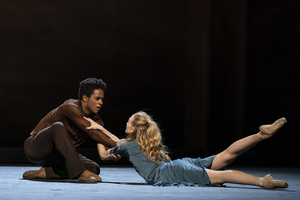Review: THE CELLIST, Royal Opera House At Home

![]() Back in the mists of time, (which was in fact only February) Covent Garden's Royal Opera House screened Dances at a Gathering / The Cellist to cinemas across the world. Having seen this beautifully moving production then, it was thrilling to see The Cellist repeated on the Royal Opera House's YouTube channel, accessible to millions across the globe.
Back in the mists of time, (which was in fact only February) Covent Garden's Royal Opera House screened Dances at a Gathering / The Cellist to cinemas across the world. Having seen this beautifully moving production then, it was thrilling to see The Cellist repeated on the Royal Opera House's YouTube channel, accessible to millions across the globe.
The Cellist is the debut work for the Royal Opera House by British choreographer Cathy Marston, celebrating the life of gifted musician Jacqueline du Pré. Having been a child prodigy, du Pré went on to become the most talented cellist of her generation and was tragically forced to give up concert playing at the age of 28 after developing multiple sclerosis.
The dance captures the two love affairs that du Pré had in her life; the one with her husband, the Argentine pianist Daniel Berenboim, and the one with her beloved Stradivarius cello. Anyone who has watched du Pré perform will see how her body beautifully moves with her instrument, entwinning so the pair almost become one entity.
Marston cleverly runs with this idea and uses a dancer as a living interpretation of the cello itself. The Instrument, as it is known, is danced by the fantastic Marcelino Sambé, who manages to capture the need of The Instrument has to be played by her. There are a few awkward moments when using a wide-legged stance, but Sambé carefully uses his body in a multitude of curling movements to suggest the shape of the cello.
He creates an individual character for The Instrument and conveys deep emotion for du Pré; reacting to both her and her moods, animating and elevating her as she becomes immersed in the music. He is delighted when she plays and wretched when she cannot.
Lauren Cuthbertson takes the title role and is wonderfully adept at conveying the wide range of emotions, from passionate love for her husband to her despair at her physical deterioration. This tragic weakening is haunting; a gentle quivering in Cuthbertson's hands and leg to the abject cruelty of her inability to play any longer. The heartbreak is clear, but is handled with great sensitivity and never strays into sentimentality.
There is intense chemistry between Cuthbertson and Sambé, with intensely joyful duets; often placed between her legs, there is a great intimacy between the dancers. It is a constant presence within the relationship between du Pré and Barenboim, known as The Conductor. Danced by a darkly charismatic Matthew Ball, his pas de deux with Cuthbertson is passionate and sensual. It is clear that there is great love and attraction between the couple. However, it is clear that this is a relationship between three, as the trio dance evocatively together, entwined and entangled.
The ballet is sensitive and ambitious, but at over an hour it is too long and could benefit from some editing. Technically the ensemble is very good and is used to convey everything from musical friends to a chorus of narrators. However, the sections where other performers appear feel busy and unexplained at points.
Philip Feeney's musical score is beautifully crafted, with segments of the music that du Pré performed: her signature piece, the Elgar concerto, but also works by Rachmaninoff, Fauré, Mendelssohn and Beethoven. These are played with great emotion and skill by the brilliant Hetty Snell.
Hildegard Bechtler's set has a brutalist feel, with an emptiness and strips of lighting that gives the sense of being inside the cello itself. The stark minimalism means all the focus can be on the dancers, without losing any appreciation of the overall look.
Directed for the screen by former ballet dancer Ross MacGibbon, the performance translates very well onto the big screen. There are lots of tight closeups, giving a real sense of the dancers' efforts. There are also atmospheric, soaring shots of the fabulous Royal Opera House interior; all the more poignant at this time.
Despite being a little long, there is a profound sense of loss and sadness in this dance. The joy of her love for her husband and her cello are eclipsed by the heart-breaking loss of du Pré's ability to realise her extraordinary talent.
The Cellist is available on the Royal Opera House's YouTube Channel
Photo Credit: Bill Cooper
Reader Reviews
Videos

